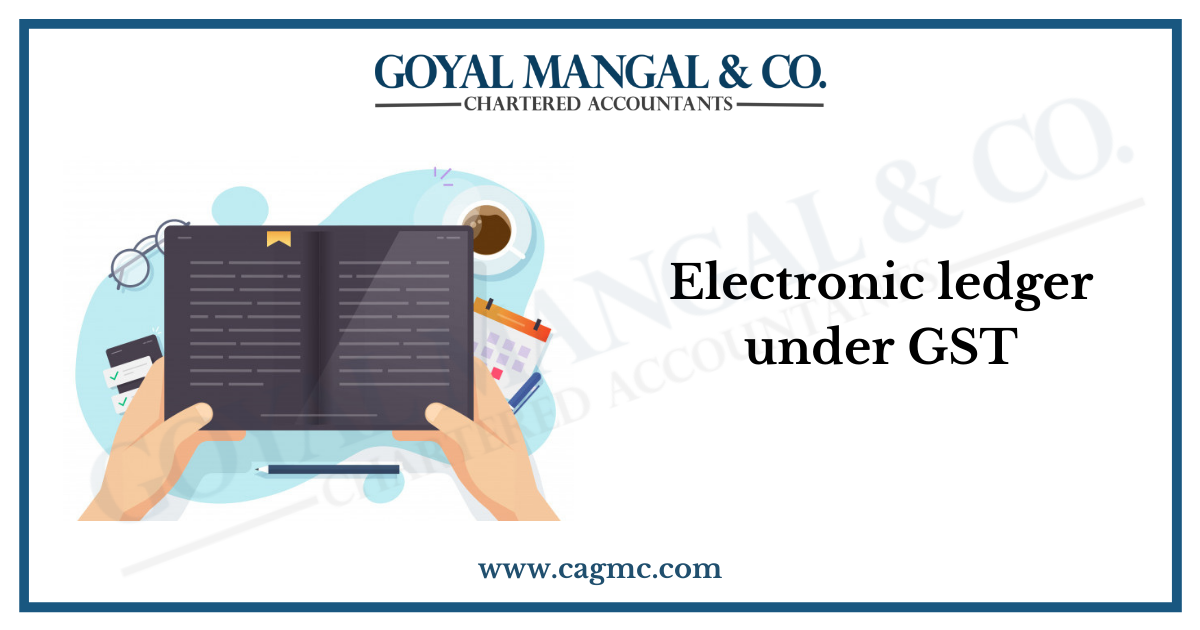| Table of Content |
Goods and Services Tax, allows taxpayer to maintain electronic ledgers on the GST portal. Taxpayer pays income tax form these electronic ledgers. Whenever a taxpayer undertakes an activity related to these electronic ledgers, the concerned ledger then gets updated in real-time. The details in the electronic ledgers get auto-populated from previous returns that were filed.

Types of Electronic ledgers

Electronic Cash ledger
Electronic Cash Ledger contains deposits that a taxpayer has made for the payment of GST. There are three heads for GST these are CGST, SGST and IGST. Each of these major heads are divided into 5 minor heads i.e. Tax, Interest, Penalty, Fees, and Others. The Electronic Cash Ledger is maintained on the GST Portal
The amount available in the electronic cash ledger can be utilized for the payment of any liability for the respective major and minor head. For example, liability for the tax under SGST/UTGST can be settled only from the available amount of cash under SGST/UTGST major Head. And hence amount of SGST/UTGST
Payment by challan
CPIN: CPIN stands for common portal identification number. The CPIN is issued at the time generating GST tax challan by online. It is 14 digit unique numbers to identify the challan. CPIN remains valid for 15 day period.
CIN: CIN stands for challan identification number that generated by banks, once payment in lieu of a generated challan is successful. It is 17 digit no. That consist 14 digit CPIN plus 3 digit bank code.
BRN: BRN stands for Bank reference number it is the transaction number given by the bank for the payment against challan.
E-FPB: E-FPB stands for electronic focal point branch. These are the branches of authorized bank which are authorised to collect payment of GST. Each authorised bank will nominate only one branch as its E-FPB for pan India transaction
Electronic Input Tax Credit Ledger
The electronic credit ledger reflects the amount of Input Tax Credit available to the taxpayer. Thus, every claim of input tax credit of the registered taxpayer eligible for claiming such a credit is credited to this ledger.
The credit in this ledger can be used to make payment of Tax only and should not be used for other purpose
Manner of utilisation of ITC
-
- The input tax credit available under the head IGST in the electronic credit ledger will first be utilized against IGST
Remaining amount if any will be utilized in the following manner:
-
- As against CGST payment
- If any amount is remaining after adjustment against CGST payment, it can be utilized to make SGST/UTGST payment
- Available CGST credit in the credit ledger shall first be utilized for the payment of CGST Remaining amount if any, will be utilized for the payment of IGST
- Available SGST/UTGST credit in the credit ledger shall first be utilized for the payment of SGST/UTGST Remaining amount if any, will be utilized for the payment of IGST
*CGST credit cannot be utilized for the payment of SGST/UTGST And visa-versa
Electronic liability ledger
This includes the tax due on GST return filing, penalty, and demands. It also displays the amount that is paid to discharge the liability through the credit balance available in the other two ledgers.
Electronic liability register will reflect the total tax liability (after netting) for the particular month.
Order of discharge of tax and other dues
There is a chronological order in which the liability of a taxable person has to be discharged:
- Self assessed tax and other dues for the previous tax periods have to be discharged first
- Self assessed tax and other dues for the current tax periods have to be discharged next
- Once these two steps are exhausted thereafter any other liability arising out of demand notice and adjudication proceeding comes last.
This sequence has to be followed mandatorily







